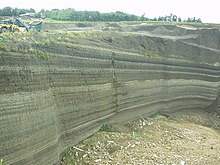
Back Vulkaan-Eifel Afrikaans Vulkaneifel German Eifel volcanique French Vulkanäifel LB Vulkaaneifel Dutch Vulkaneifel Swedish




The Volcanic Eifel or Vulkan Eifel (German: Vulkaneifel), also known as the East Eifel Volcanic Field (EEVF),[1] is a region in the Eifel Mountains in Germany that is defined to a large extent by its volcanic geological history. Characteristic of this volcanic field are its typical explosion crater lakes or maars, and numerous other signs of volcanic activity such as volcanic tuffs, lava streams and volcanic craters like the Laacher See. The Volcanic Eifel is still volcanically active today. One sign of this activity is the escaping gases in the Laacher See.
- ^ van den Bogaard, P.; Hall, C. M.; Schmincke, H.-U.; York, D. (30 November 1989). "Precise single-grain 40Ar/39 Ar dating of a cold to warm climate transition in Central Europe". Nature. 342 (6249): 523–525. doi:10.1038/342523a0. ISSN 1476-4687. Retrieved 19 December 2023.
© MMXXIII Rich X Search. We shall prevail. All rights reserved. Rich X Search